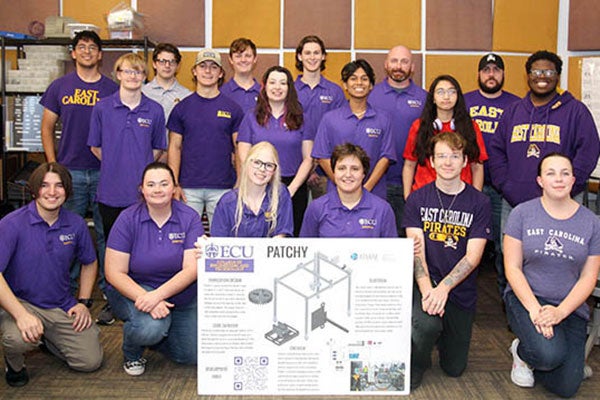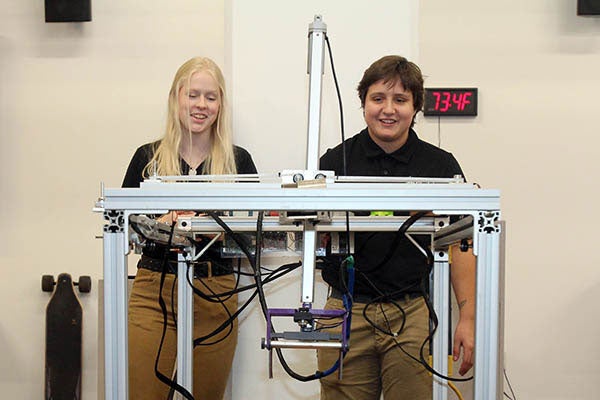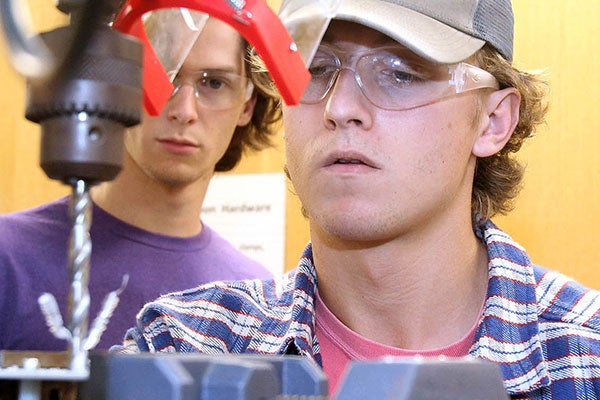ECU robot delivers second-place finish in national competition
When handed lemons, students in East Carolina University’s College of Engineering and Technology didn’t just make lemonade. They made a robot that could deliver it.

The ECU ATMAE robotics team placed second in a national competition for building Patchy, a robot designed to sort and move materials. (Photos by Ken Buday)
ECU’s Association of Technology, Management and Applied Engineering (ATMAE) robotics team recently placed second in a national competition for building a robot that could sort and move materials.
“We were all really excited about that,” Olivia Sawtell, student president of ECU’s ATMAE robotics team, said about the second-place finish. “We went into it just wanting to have fun, but it always makes it a little sweeter when we place.”
The students traveled to Atlanta for the ATMAE national conference that included the robotics competition. Teams had to create a robot to solve a materials handling problem — the lemons if you will.
Sawtell said team members consulted with Hyster-Yale in Greenville and BSH in New Bern to develop the robot that had the ability to identify and select the proper box from a pallet and then place them in specific locations — the lemonade.
“We created a gantry crane system that uses an AI (artificial intelligence) vision system to pick up and move the boxes, sort them into separate piles if needed, set them on conveyer belts or onto other places to be dealt with,” Sawtell said.

Darby Waters, left, and Olivia Sawtell, members of ECU’s ATMAE robotics team, demonstrate Patchy in the Science and Technology Building.
She said an interdisciplinary team of students from the departments of computer science, technology systems and engineering drew on their skills and inventiveness to create the robot they named Patchy. Work started in March as ideas sprang to life and continued throughout the summer with design development. In September, team members began to create and purchase parts and then assemble the robot.
“We start by breaking up into teams,” Sawtell said. “We just sort of poll everybody to find out what they’re interested in and what their backgrounds are in. You work in your team for about the first month while we’re getting everything together, and then every team has to come together, and what we’ve been working on now has to go together and work as one big piece.”
Sawtell said the students experienced many challenges, including power supply issues, sensor errors, 3D part printing complications, and perhaps the biggest: “trying to make sure everything fit together the way we thought it would.”
Judges consider documentation and paperwork, original fabrication and computer coding, and functionality when awarding prizes.
“Most of all, it’s about innovation and that the team really put in the work and it’s not something that’s just off the shelf and already exists,” Sawtell said.

Members of the ATMAE robotics team drill a hole in a metal part as they build a robot for the national competition.
A junior from Kitty Hawk, Sawtell has plenty of experience as a member of ATMAE, but building the robot always provides lessons.
“Every year I learn more and more about code,” she said. “It’s probably one of my weakest points, and this year I definitely learned a little more about how AI actually works and what goes into training a model to identify certain things and how it learns as well as a little bit about how control code works. As long as I’ve been on the team, I’ve worked with the electrical and fabrication, so I have a pretty good handle on that, but I feel like I’m always learning new stuff.”
She said that opportunity to learn will continue throughout the next semester for ATMAE students.
“We have a ton of ideas and a ton of projects we’re working on,” Sawtell said. “We’re getting ready to start on three other robots to go along with this that are companions. It really doesn’t matter your skill level, we love to help people learn. As long as you’re willing to learn, we’re willing to teach you. We love when people are invested in it and want to know more about it.”
Also as part of the conference, ECU engineering student Heath Faircloth placed second in the student technology IQ challenge. As part of the competition, students answer questions in a Jeopardy-style format in categories such as manufacturing, communication, construction, safety electronics, energy, equality and management.
Beyond Sawtell and Faircloth, other members of the ATMAE robotics team include: Aiden Altman; Caleb Anderson; Jackson Barbour; Mike Campbell; Kiran Cornejo; Yasmin Mata-Delgado; Jarred Desrosiers; Adam Epley; Ismael Galarza; Jameson Gerdts; John Lee; Alec Lozano; Angel Parker; Sven Reyes; Katie Sperry; Darby Waters; and Landy Waters. Faculty advisors include Bill McClung and Amy Frank.
Anyone interested in ECU’s ATMAE student organization can email the club.